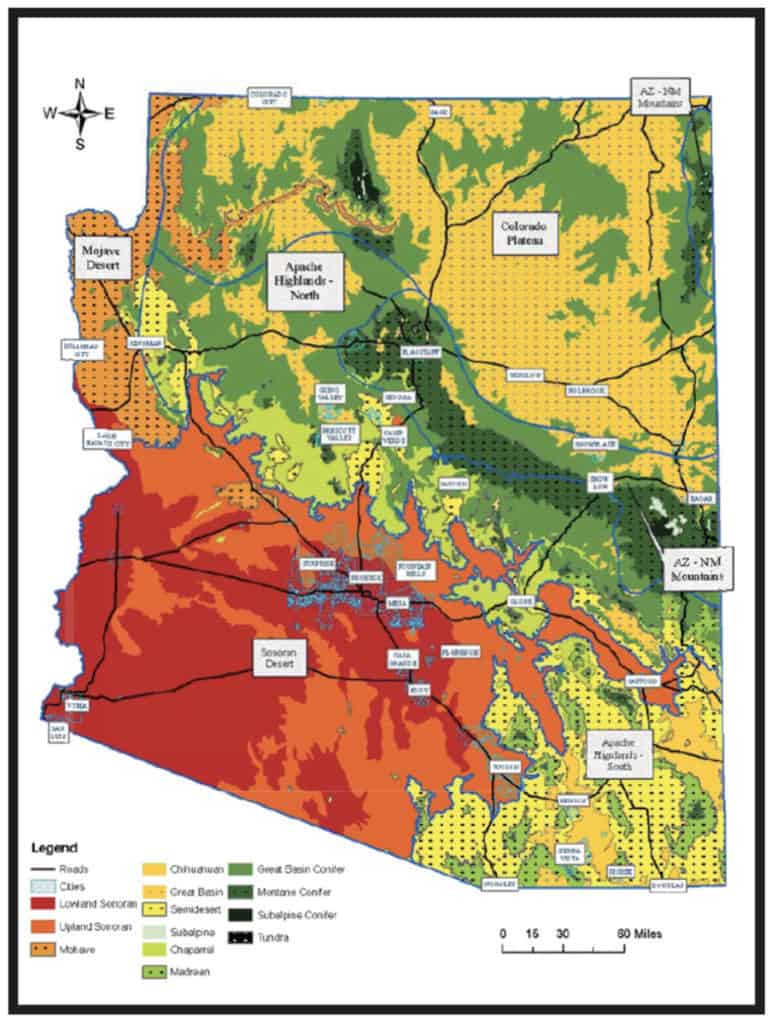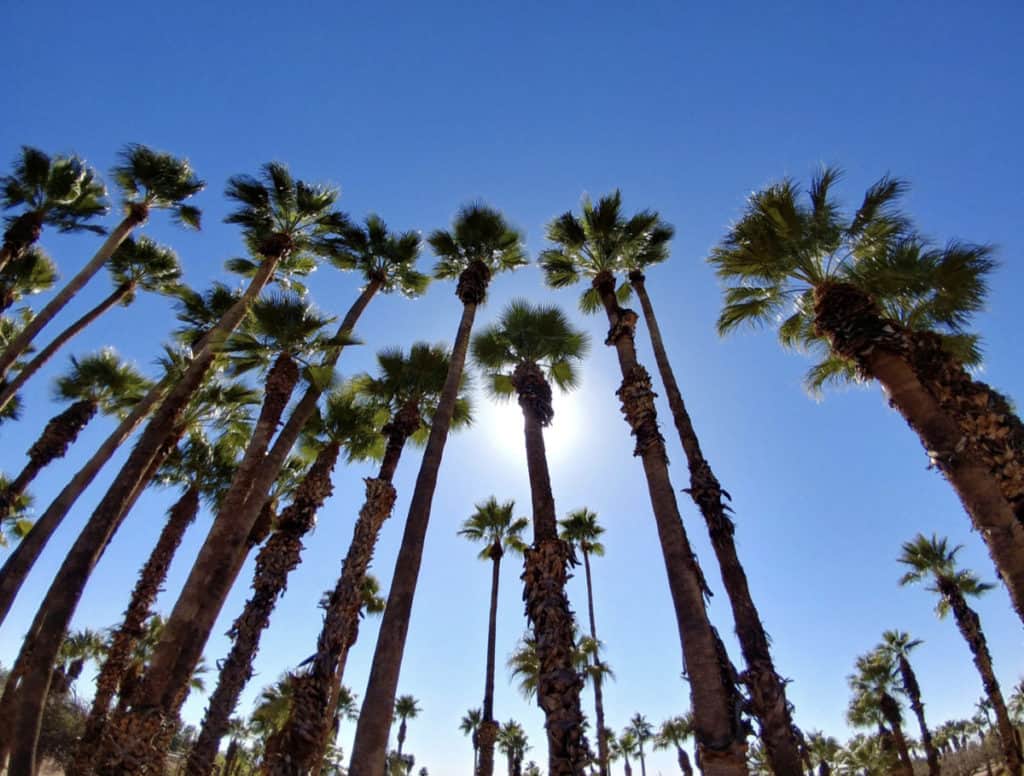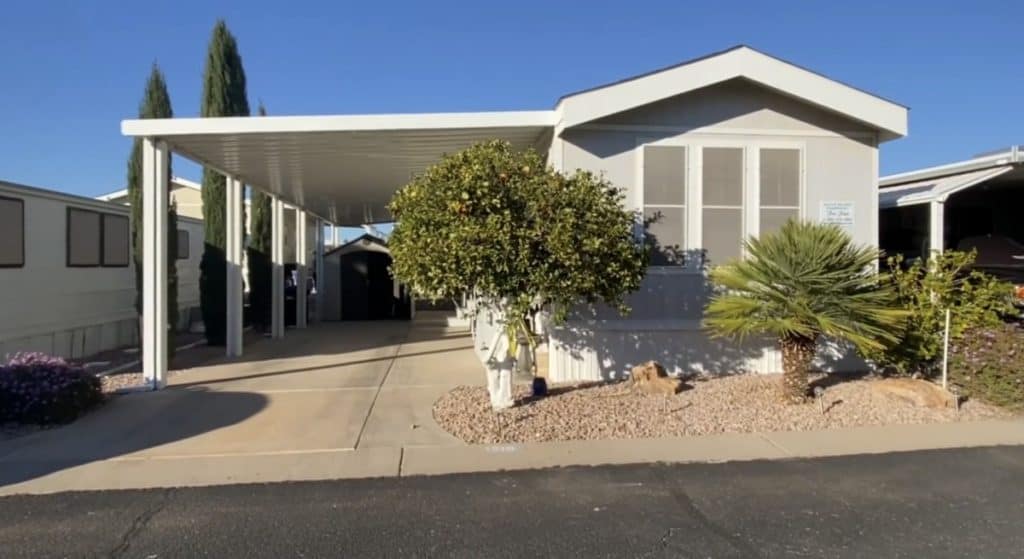
55plus parks are so often beautifully manicured. Arizona parks focus on desert plants capable of thriving year round. They are a beautiful background to Snowbird life.
Arizona parks typically have cactus (Barrel, Hedgehog, Prickly Pear, and the Saguaro – a Sonoran Desert icon) and palm trees (Queen, Royal, Date, Mediterranean, Mexican Fan, Canary Island Date, and California Fan Palm trees) and large varieties of grapefruit, orange, lemons and lime trees.
When one thinks of Arizona we tend to think of cactus and palm trees. We most often think of the Saguaro cactus of the Sonora Desert and the tall Mexican Fan Palm tree. But desert habitat is much more diverse and parks are embracing some of that diversity.
Watch for the wide variety of fruit trees too. Many have fruit that can be enjoyed through most of your stay. And if you don’t have a fruit tree on your site ask a neighbor in the park. Often, fruit trees produce far more than one resident can consume and they’d welcome you helping yourself if you ask.
Drive through any park model and manufactured home park and look at the diversity of the plant life. You’ll marvel at the cactus variety, the ground cover, and the palms that dot the roadways.
ECOLOGY – SOUTHWEST AZ DESERT
According to the US Department of Transportation Vegetation Management division Arizona Snowbird living is largely built on the Sonora Desert Lowland and Uplands. These SW AZ regions are a draw to those desiring warm winter climate and the plant life reflects just that.

CACTUS – A DEFINING FEATURE OF THE AZ SONORA DESERT
Some say palm trees define snowbird living and others clearly say it’s the cactus. We believe cactus wins. The Sonoran Desert cactus, the Saguaro Cactus, is only found in the Sonoran Desert of Arizona and the Sonoran state of Mexico south of Tucson, AZ. Where else can you see a 40 foot cactus that is decades old.

“Every time we see a Saguaro in a Snowbird park we wonder of how long it has been there.”
Sure, there are many other cactus that you can find outside the homes of park residents and they too are a wonder. But a towering Saguaro is simply a wonder found in that one desert in the US.
PALM TREES – AM I REALLY IN THE DESERT?
The first time we arrived at a Snowbird park in Arizona we were so surprised to see palm trees growing to towering heights. They were so very, very tall! They almost made a person dizzy.

Why are they there?… That’s a good question.
The Canary Island Palm tree is native to the Canary Islands, grows to 50 feet when mature and has long 10-15 foot leaves that cascade down to create a canopy. California Fan Palms grow 60 plus feet tall with fan shaped leaves and 10-15 foot fronds, divided leaves, which is widely regarded as one of the most popular desert palm trees. The Mexican Fan Palm grows as high as 100 feet tall and are robust and cold weather resistant. You can see a mix of all of these in the parks throughout the Sonora Desert valley of SW Arizona. Look for each as you travel. Each are so beautiful.
Except for the California Fan Palms in the Kofa National Wildlife Refuge, no palm trees are truly native to Arizona.
FRUIT TREES – BREAKFAST ON THE DECK EACH MORNING
We love waking in the morning and enjoying coffee and fresh fruit from a nearby friend’s tree. Naval oranges are our favourite to eat and juice. And the Ruby Red is our go to grapefruit to share together.

With Grapefruit (Ruby Red, Rio Red, and Oro Blanco), oranges (Navel, Blood, Cara Cara, Trovita, and all the Arizona Sweets varieties), Mandarins / Tangerines (the Tango, Golden Nugget, Clementine), Lemons (the common Improved Meyer, Eureka, Lisbon), Limes (the common Key Lime), and other citrus like the Limequat, Tangelo, and Sour Orange can be seen in many retirement communities and single family dwelling yards. CLICK HERE to open a new tab with more info and great pictures from the Summer Winds Nursery Arizona website summerwindsnursery.com.
GROUND COVER AND FLOWERS
Summer is a time of flowering for much of the desert ground cover. A wild array of flowers take shape in the late spring and early summer. These rarely make park foliage but you will experience many varieties in walks and hikes in the desert region. If you stay late enough into the Spring you may enjoy colorful views you rarely see in the winter.

PARK RULES – WILL THE PARK ALLOW YOUR PLANT
In a follow up post we will be explaining more about how to choose, plant, and care for your choice of plant(s). Some 55 plus community parks provide a service to plant a citrus tree like a grapefruit, orange, lemon or lime. We simply went up to the park office one day early Spring and asked for an orange tree. For no charge they planted it and installed irrigation lines. We will have oranges in 2-3 years!
But whatever plants you choose be sure to check with you park and with friends in the region. You’ll want plants that you can be sure will provide you the enjoyment you want and live a healthy life in the heat of Arizona while you are away.

CONCLUSION
Arizona parks are full of cactus and often palm trees. Fruit trees even offer color and fruit to enjoy during your stay. Look closely at what is planted outside each residence in your community park. You may find some of the Sonora Desert’s best kept secrets. It’s a beautiful sight!
LEARN MORE
Planting and caring for your outdoor plants – Coming soon!
